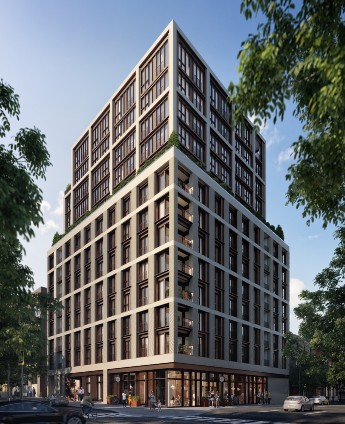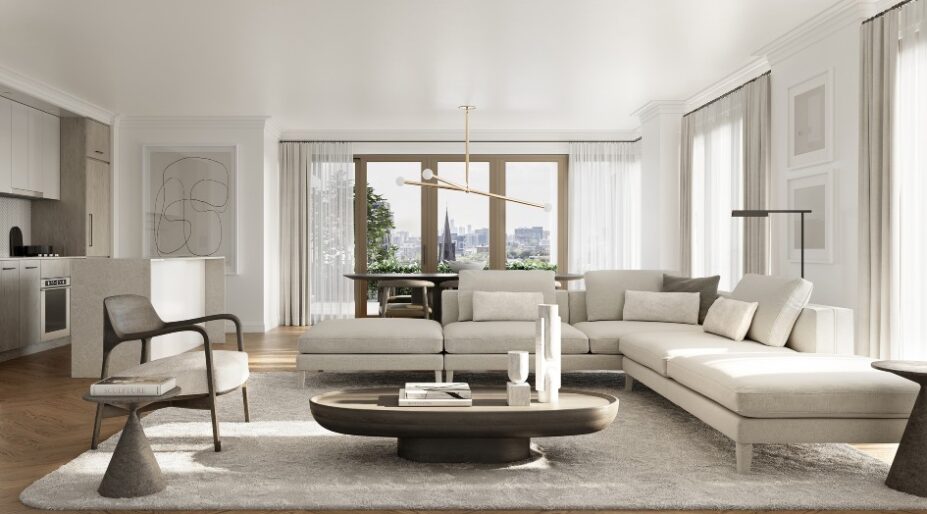123 Portland, a brand new boutique condominium in downtown Toronto’s King West neighbourhood, developed by Minto Communities, is the first in Canada to pilot the WELL for residential program, which sets out to create healthier, more resilient homes.
The WELL standard came onto the scene 10 years ago and has since widened its scope based on evolving research. Described as a roadmap for creating and certifying spaces that advance human health and well-being, the program has manifested throughout offices and other commercial spaces. It’s been called the first people-centred standard for the built environment. By implementing ten wellness concepts: air, water, nourishment, light, movement, thermal comfort, sound, materials, and mind and community, spaces can exceed industry averages in performance and sustainability.
But applying WELL to residential buildings has never materialized until recently. In fact, standards and regulations focused on resident health are lacking overall. Carl Pawlowski, senior manager of sustainability at Minto Communities, says the pandemic is one key motivator that has pushed people to focus on health and well-being in general. This new iteration presents an evidence-based approach that shows what features can actually impact condo residents and staff when they’re inside their buildings. “It gives some trust and validation,” he says.
There is also the larger impact it holds for the overall housing market, according to Olesy Alekseev, vice-president and Canada lead for the International WELL Building Institute. “As we set out to address the growing housing demand for the rapidly increasing population in Canada, it is essential to prioritize healthy homes designed, built and operated for long-term resilience,” he said in a statement last November.
Over the past two years, a team of 20 builders and developers worked alongside more than 100 advisors from the IWBI to bring various insights and recommendations to the new program, which consists of more than 100 health strategies for both new and existing residences, from single-family homes to multi-residential buildings. When it opened for enrollment last year, 25 pilot participants from around the world jumped on board, including Minto Communities.
Before that, Minto had been pursuing the existing version of the WELL standard at 123 Portland until it switched over midstream. Pawlowski says the change just made sense. One reason is it doesn’t follow some of the traditional scoring framework seen in commercial buildings.
“There are no Silver, Gold and Platinum (certification levels) that you’ll see in the existing standard,” he explains. “It’s more like a scale, so the idea is more tangible to homeowners where their unit would achieve x number of points out of 198. That’s a bit easier to comprehend how the unit is performing.”

The exterior envelope is insulated with glazing that offers sufficient daylight and maintains energy efficiency. Photo courtesy of Minto.
Fundamentally, all the categories of WELL remain the same, but once a developer digs into the details, weighing them might be different within a residential context or due to the technical requirements. Some might be more relevant in a home where people are spending the majority of their time.
As Pawlowski explains, there are components that can be tied to the units or common areas. It depends on the exact requirements and where it makes sense to implement features.
“Looking at air quality for example, people are spending all night sleeping in their suite, so maybe you’re going to prioritize that over spending money on a common area where people are there for maybe only an hour,” he says. “In terms of sound attenuation, maybe you’re doing a bit more around the gym or units adjacent to those areas.”
The 116-suite condo has been under construction for a number of years. Residents began moving into their units in December 2023, with more to follow. The Parisian-inspired condo has all the fittings one would expect these days—a 24-hour concierge, parcel storage, a co-working space and building-wide Wi-Fi—but there’s much more when it comes to health and wellness.
Those who are using the gym will find noise-reducing flooring and towering windows for natural light. On the roof, 15-storeys up, are unprogrammed spaces for morning fitness routines and lush green plantings that connect residents to nature. Biophilic design is also incorporated into the interior finishing through natural and textured materials.
To keep air quality high, the design used low volatile organic compound paints, sealants, adhesives, flooring materials and insulation, supported by an ionized air system. Chemical and scent-free cleaning systems are used in the common areas.
The amenities are designed to “catalyze social interaction,” such as the lounge area. According to the website, they aim to inspire a mindful routine and “reestablish what it means to connect as a community.”
Companies earn the WELL Residence seal upon completion of third-party review and verification of the selected strategies the developer used. A home must achieve a minimum of 40 points to become certified. Projects can also become pre-certified as a WELL Residence before construction so that developers can communicate that at the sales launch. “People aren’t waiting a year or two after occupancy to get certification; they can see it’s been reviewed and verified before they even make a purchasing decision,” says Pawlowski. “Especially in the market today it is a huge differentiation.”
Pending how the pilot goes and if it meets certain expectations, Minto will look at its portfolio and consider undertaking the standard at other buildings.
“With the standard being applicable to both new and existing buildings, it also means that if we design a building to achieve 80 points, an individual unit owner can, down the road, make improvements to their suite to bring their score up. That will differentiate their unit versus the rest in the building or other homes in the community.
“This makes it a bit more tangible to them and it gives them an opportunity to be engaged in the process. . . and a framework to work off of. I think that’s really interesting for keeping the program moving forward.”



